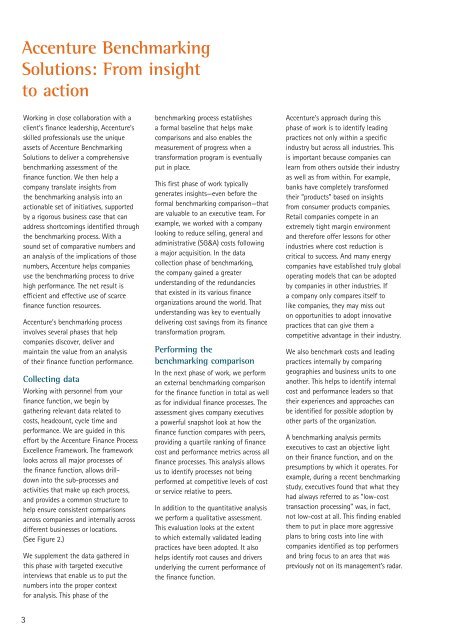Accenture Benchmarking Solutions From Insight to Action
Accenture Benchmarking Solutions From Insight to Action
Accenture Benchmarking Solutions From Insight to Action
You also want an ePaper? Increase the reach of your titles
YUMPU automatically turns print PDFs into web optimized ePapers that Google loves.
<strong>Accenture</strong> <strong>Benchmarking</strong><br />
<strong>Solutions</strong>: <strong>From</strong> insight<br />
<strong>to</strong> action<br />
Working in close collaboration with a<br />
client’s finance leadership, <strong>Accenture</strong>’s<br />
skilled professionals use the unique<br />
assets of <strong>Accenture</strong> <strong>Benchmarking</strong><br />
<strong>Solutions</strong> <strong>to</strong> deliver a comprehensive<br />
benchmarking assessment of the<br />
finance function. We then help a<br />
company translate insights from<br />
the benchmarking analysis in<strong>to</strong> an<br />
actionable set of initiatives, supported<br />
by a rigorous business case that can<br />
address shortcomings identified through<br />
the benchmarking process. With a<br />
sound set of comparative numbers and<br />
an analysis of the implications of those<br />
numbers, <strong>Accenture</strong> helps companies<br />
use the benchmarking process <strong>to</strong> drive<br />
high performance. The net result is<br />
efficient and effective use of scarce<br />
finance function resources.<br />
<strong>Accenture</strong>’s benchmarking process<br />
involves several phases that help<br />
companies discover, deliver and<br />
maintain the value from an analysis<br />
of their finance function performance.<br />
Collecting data<br />
Working with personnel from your<br />
finance function, we begin by<br />
gathering relevant data related <strong>to</strong><br />
costs, headcount, cycle time and<br />
performance. We are guided in this<br />
effort by the <strong>Accenture</strong> Finance Process<br />
Excellence Framework. The framework<br />
looks across all major processes of<br />
the finance function, allows drilldown<br />
in<strong>to</strong> the sub-processes and<br />
activities that make up each process,<br />
and provides a common structure <strong>to</strong><br />
help ensure consistent comparisons<br />
across companies and internally across<br />
different businesses or locations.<br />
(See Figure 2.)<br />
We supplement the data gathered in<br />
this phase with targeted executive<br />
interviews that enable us <strong>to</strong> put the<br />
numbers in<strong>to</strong> the proper context<br />
for analysis. This phase of the<br />
3<br />
benchmarking process establishes<br />
a formal baseline that helps make<br />
comparisons and also enables the<br />
measurement of progress when a<br />
transformation program is eventually<br />
put in place.<br />
This first phase of work typically<br />
generates insights—even before the<br />
formal benchmarking comparison—that<br />
are valuable <strong>to</strong> an executive team. For<br />
example, we worked with a company<br />
looking <strong>to</strong> reduce selling, general and<br />
administrative (SG&A) costs following<br />
a major acquisition. In the data<br />
collection phase of benchmarking,<br />
the company gained a greater<br />
understanding of the redundancies<br />
that existed in its various finance<br />
organizations around the world. That<br />
understanding was key <strong>to</strong> eventually<br />
delivering cost savings from its finance<br />
transformation program.<br />
Performing the<br />
benchmarking comparison<br />
In the next phase of work, we perform<br />
an external benchmarking comparison<br />
for the finance function in <strong>to</strong>tal as well<br />
as for individual finance processes. The<br />
assessment gives company executives<br />
a powerful snapshot look at how the<br />
finance function compares with peers,<br />
providing a quartile ranking of finance<br />
cost and performance metrics across all<br />
finance processes. This analysis allows<br />
us <strong>to</strong> identify processes not being<br />
performed at competitive levels of cost<br />
or service relative <strong>to</strong> peers.<br />
In addition <strong>to</strong> the quantitative analysis<br />
we perform a qualitative assessment.<br />
This evaluation looks at the extent<br />
<strong>to</strong> which externally validated leading<br />
practices have been adopted. It also<br />
helps identify root causes and drivers<br />
underlying the current performance of<br />
the finance function.<br />
<strong>Accenture</strong>’s approach during this<br />
phase of work is <strong>to</strong> identify leading<br />
practices not only within a specific<br />
industry but across all industries. This<br />
is important because companies can<br />
learn from others outside their industry<br />
as well as from within. For example,<br />
banks have completely transformed<br />
their “products” based on insights<br />
from consumer products companies.<br />
Retail companies compete in an<br />
extremely tight margin environment<br />
and therefore offer lessons for other<br />
industries where cost reduction is<br />
critical <strong>to</strong> success. And many energy<br />
companies have established truly global<br />
operating models that can be adopted<br />
by companies in other industries. If<br />
a company only compares itself <strong>to</strong><br />
like companies, they may miss out<br />
on opportunities <strong>to</strong> adopt innovative<br />
practices that can give them a<br />
competitive advantage in their industry.<br />
We also benchmark costs and leading<br />
practices internally by comparing<br />
geographies and business units <strong>to</strong> one<br />
another. This helps <strong>to</strong> identify internal<br />
cost and performance leaders so that<br />
their experiences and approaches can<br />
be identified for possible adoption by<br />
other parts of the organization.<br />
A benchmarking analysis permits<br />
executives <strong>to</strong> cast an objective light<br />
on their finance function, and on the<br />
presumptions by which it operates. For<br />
example, during a recent benchmarking<br />
study, executives found that what they<br />
had always referred <strong>to</strong> as “low-cost<br />
transaction processing” was, in fact,<br />
not low-cost at all. This finding enabled<br />
them <strong>to</strong> put in place more aggressive<br />
plans <strong>to</strong> bring costs in<strong>to</strong> line with<br />
companies identified as <strong>to</strong>p performers<br />
and bring focus <strong>to</strong> an area that was<br />
previously not on its management’s radar.

















